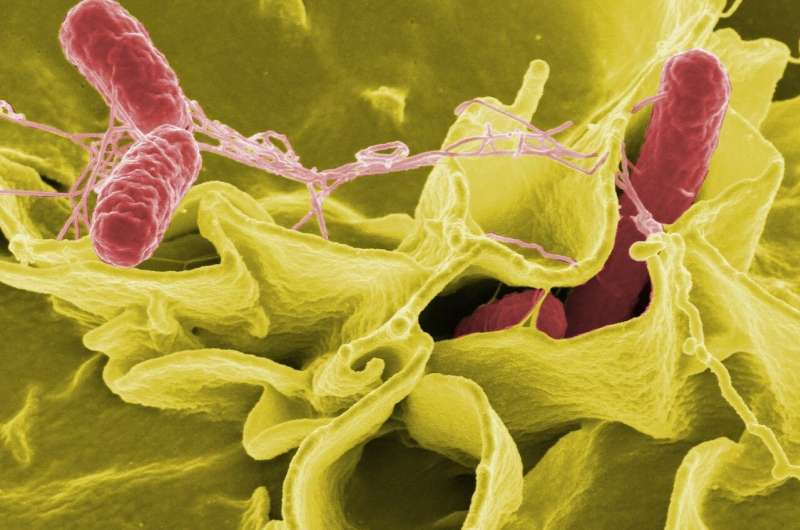Intracellular bacteria use sophisticated 'hack' to evade a host's immune system - Phys.org

Researchers at UC Davis have discovered a signaling mechanism that allows bacteria like Salmonella to evade destruction by the host's immune system.
Intracellular bacteria like Salmonella can infect macrophages, a type of immune cell. The Salmonella triggers the death of the host macrophage. It then tricks other immune cells into safely delivering them into another macrophage rather than destroying them.
"The Salmonella outmaneuvers host defenses by using one of our best weapons and turning it against us. It is kind of ingenious," said Andreas Bäumler, senior author of the study. Bäumler is vice-chair of research and professor in the Department of Medical Microbiology and Immunology at UC Davis School of Medicine.
The study, performed on mouse tissue cultures, was published in Cell Host & Microbe.
Pathogens hiding in immune cells
The complement system, part of our immune system, is responsible for cleaning up pathogens, including bacteria. It either directly kills the pathogen or targets it for destruction by other immune cells.
Neutrophils are immune cells that the complement system recruits to deal with bacteria. "Their job is to kill bacteria. If you scrape your skin, you survive because the neutrophils take care of the random bacteria that come in," Bäumler explained.
Macrophages are another type of immune cell that cleans up dead and dying cells. They actively engulf bacteria and other cellular debris, but they are not as effective at killing bacteria as neutrophils.
Bacteria like Salmonella survive within macrophages in a membrane-enclosed vacuole, or compartment. Being within the macrophage allows them to avoid detection by other immune cells, such as bacteria-killing neutrophils.
But macrophages only live about 30 days, so intracellular bacteria like Salmonella must periodically find a new host cell. And they need to do so without being detected and destroyed by the immune system.
The researchers found that the Salmonella bacteria that have infected a macrophage use particular weapons—virulence factors—to create holes in the membranes of both the vacuole and the macrophage to trigger macrophage death, thereby opening channels to the outside.
These holes allow the bacteria to activate the complement system and generate a "find-me" signal to attract neutrophils to find bacteria entrapped in dying macrophages.
When a neutrophil arrives to clean up the dead macrophage with the Salmonella inside, it engulfs both the dead macrophage and the Salmonella in a process called efferocytosis.
The dead macrophage then shields the Salmonella from the antimicrobial properties of the neutrophil, allowing the bacteria to survive.
Thus, Salmonella hijacks key aspects of the host immune system, namely the complement system and neutrophils, in order to persist within the infected host.
"When the pathogen triggers the host complement system by virulence factor-induced perforation within a host macrophage—which generates a signal for efferocytosis—the system doesn't work anymore. Neutrophils become a safe site for the Salmonella," said Hirotaka Hiyoshi, the lead author for the study.
Hiyoshi, formerly assistant project scientist in the UC Davis Department of Medical Microbiology and Immunology, is now an assistant professor in the Department of Bacteriology at Nagasaki University in Japan.
Understanding the mechanism may help future treatments
Salmonella is just one type of intracellular bacteria that can cause disease in people. Other pathogens that live inside cells include Brucella abortus, Listeria monocytogenes, Chlamydia trachomatis, Coxiella burnetii and Mycobacterium tuberculosis.
The researchers also demonstrated that Brucella uses the same mechanism as Salmonella to evade the host immune system, suggesting that this virulence strategy may be shared by other bacterial pathogens that can live within host cells.
While some of these bacterial infections may resolve on their own, they often require treatment with antibiotics. In the coming decades, resistance to antibiotics is expected to significantly increase, meaning they may no longer be effective against intracellular pathogens.
"Multi-drug resistance is on the rise, and by 2050, multi-drug resistant bacteria are projected to be the number one cause of death. This is why we need to understand these diseases to find a vulnerability in their strategies. Once you understand the mechanism, you may be able to develop a new target treatment," said Bäumler.
Additional authors on the study include Bevin C. English, Vladimir E. Diaz-Ochoa, Tamding Wangdi, Lillian F. Zhang and Renée M. Tsolis from the UC Davis Department of Medical Microbiology and Immunology; Miako Sakaguchi from the Institute of Tropical Medicine, Nagasaki University, Japan; and Takeshi Haneda from the School of Pharmacy, Kitasato University, Japan.
Explore further
Citation: Intracellular bacteria use sophisticated 'hack' to evade a host's immune system (2022, February 9) retrieved 27 February 2022 from https://phys.org/news/2022-02-intracellular-bacteria-sophisticated-hack-evade.html
This document is subject to copyright. Apart from any fair dealing for the purpose of private study or research, no part may be reproduced without the written permission. The content is provided for information purposes only.
Comments
Post a Comment